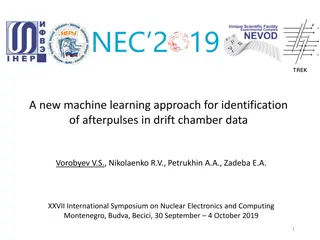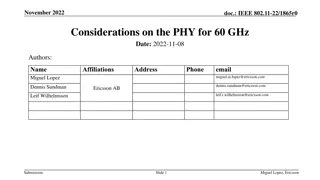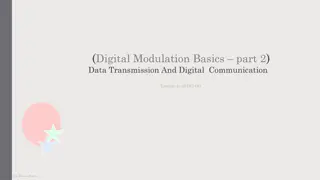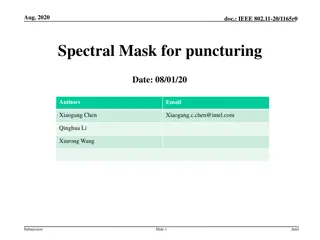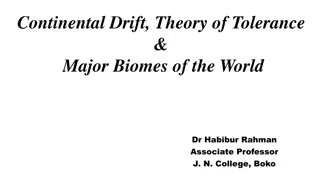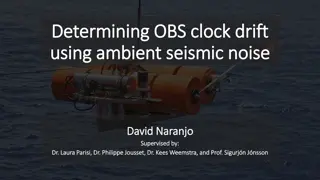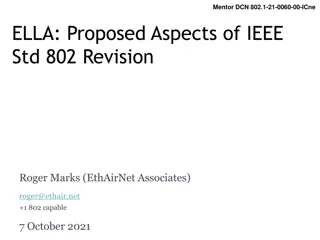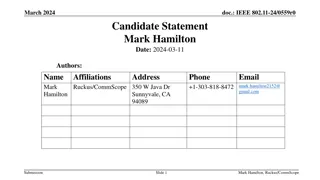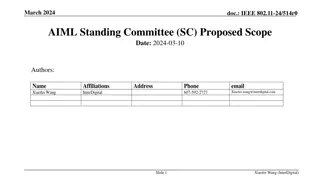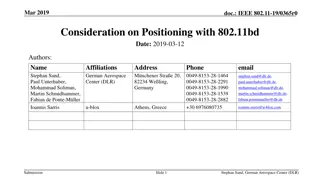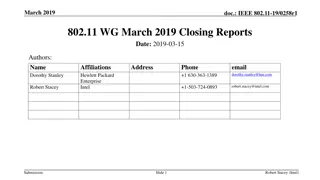Amplitude Drift Compensation in IEEE 802.11-17/1374r0 Document
The document discusses Amplitude Drift Compensation in the context of EVM tests for IEEE 802.11 devices. It highlights the challenges posed by amplitude drift, the impact on EVM degradation, and the need for compensation mechanisms. Various authors from different affiliations contribute insights on the issue, emphasizing the importance of mitigating amplitude drift to ensure transceiver accuracy and performance.
Download Presentation

Please find below an Image/Link to download the presentation.
The content on the website is provided AS IS for your information and personal use only. It may not be sold, licensed, or shared on other websites without obtaining consent from the author. Download presentation by click this link. If you encounter any issues during the download, it is possible that the publisher has removed the file from their server.
E N D
Presentation Transcript
September 2017 doc.: IEEE 802.11-17/1374r0 On Amplitude Drift Compensation Date: 2017-09-01 Authors: Name Affiliation Address Phone Email Jianhan Liu Frank Hsu Thomas Pare jianhan.Liu@mediatek.com frank.hsu@mediatek.com thomas.pare@mediatek.com Mediatek Hongyuan Zhang Marvell hongyuan@marvell.com Bin Tian Qualcomm btian@qti.qualcomm.com Ron Porat Broadcom ron.porat@broadcom.com Xiaogang Chen Ross Yu David Yang Jinsoo Choi Yujin Noh Minho Cheong Bo Sun Intel xiaogang.c.chen@intel.com ross.yujian@huawei.com david.yangxun@huawei.com js.choi@lge.com yujin.noh@newracom.com minho.cheong@newracom.com sun.bo1@zte.com.cn Huawei LGE Newracom ZTE Tianyu Wu Samsung Submission Slide 1 Jianhan Liu, etc., Mediatek
September 2017 doc.: IEEE 802.11-17/1374r0 EVM test with amplitude drift It is noticed that EVM degradation caused by amplitude drift can be pretty large. HT and VHT devices on the market allow amplitude drift compensation in the EVM test. For HE products, it is reasonable to reduce EVM degradation caused by amplitude drift. Therefore 11ax added the following requirement to the EVM test : The text in the 11ax draft 1.2 (28.3.18.4.4 Transmitter modulation accuracy (EVM) test) says: d) Symbols in a PPDU shall be derotated according to estimated frequency offset. Sampling offset drift shall be also compensated. Note that amplitude drift shall not be compensated by the testing instrument. Submission Slide 2 Jianhan Liu, etc., Mediatek
September 2017 doc.: IEEE 802.11-17/1374r0 EVM degradation caused amplitude drift Amplitude drift is caused by PA self-heating. Even with enhanced PA design, it is hard to reduce amplitude drift to zero. For MCS 10 and 11, EVM is below -35dB. EVM Degradation Caused by Amplitide Drifting -25 It can be seen that the lower the EVM, the more sensitive to amplitude drift. For example, for 0.05dB delta amplitude drift: EVM degrades from -38dB to - 35dB EVM degrades from -31dB to - 30dB. -30 EVM (dB) -35 -40 0.1 0.15 0.2 0.25 Amplitide Drifting (dB) 0.3 0.35 0.4 0.45 0.5 It is not a easy task to control the delta amplitude drift smaller than 0.05dB! Submission Slide 3 Jianhan Liu, etc., Mediatek
September 2017 doc.: IEEE 802.11-17/1374r0 More reasons on relaxing EVM requirements caused amplitude drift WiFi receivers can have Amplitude/Phase/Frequency tracking capability. Completely disallowing the amplitude tracking in the test does not reflect the true condition of some receivers. Completely disallowing amplitude drift compensations increase the cost and power consumptions of PA, for example, PA need to be built with very accurate temperature measurement and gain compensation circuits to avoid the amplitude drift caused by PA self-heating. HT and VHT devices on the market allows amplitude drift compensation in the EVM test and we did not see inter-operable problem caused by amplitude drift compensation . Submission Slide 4 Jianhan Liu, etc., Mediatek
September 2017 doc.: IEEE 802.11-17/1374r0 Minimize the change of the 11ax spec. Only change the EVM test for MCS 10-11 with amplitude drift: 1. Only low EVMs are sensitive to amplitude drift; 2. Avoid change of -27dBm for HE TB PPDU. Slide 5 Submission Jianhan Liu, etc., Mediatek
September 2017 doc.: IEEE 802.11-17/1374r0 Suggested changes on EVM test Putting an requirement on EVM degradation caused by amplitude drift for HE products is a good move, but making the requirement too strict may hurt the industry. Given there are no HE products on the mass production yet, it is hard to guarantee that HE products can reduce the amplitude drift to zero. Note that even 0.01dB amplitude drift can cause 0.5dB EVM change in very low EVM regions. To reduce the risk for HE products and also avoid huge EVM degradation caused by amplitude drift, we propose to relax the 28.3.18.4.4 Transmitter modulation accuracy (EVM) test) for MCS10-11 (1024QAM). Submission Slide 6 Jianhan Liu, etc., Mediatek



